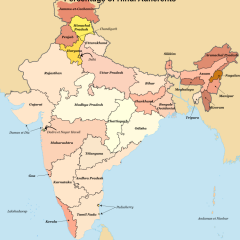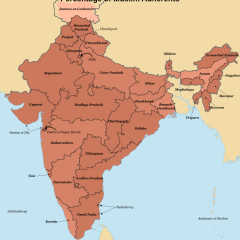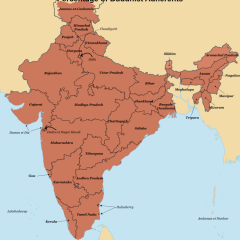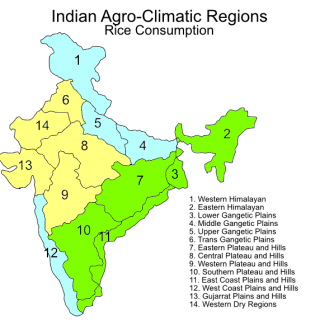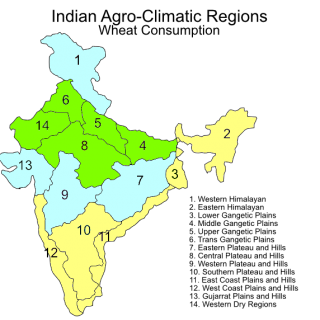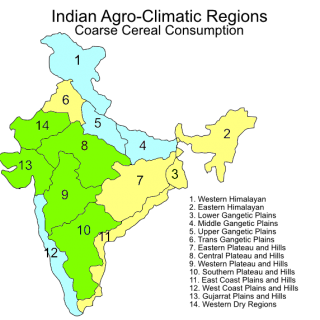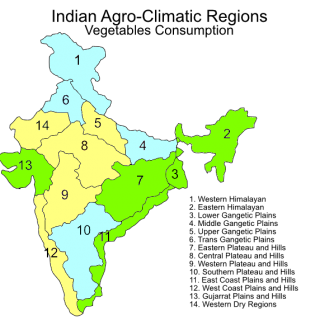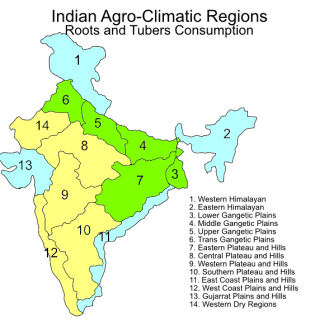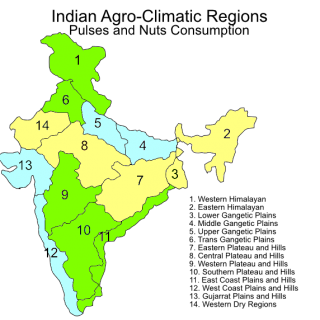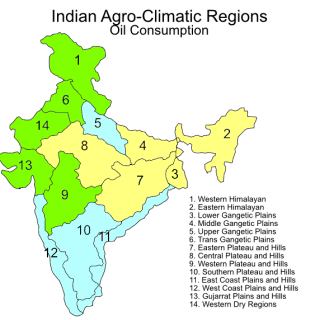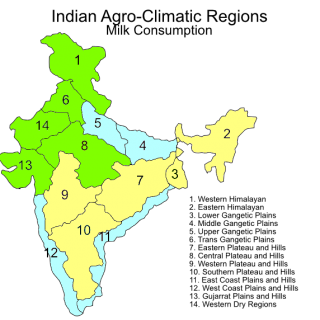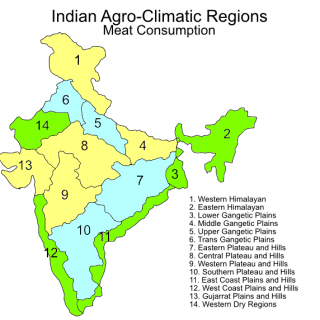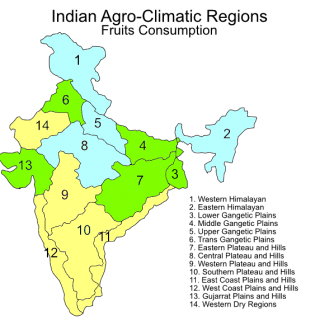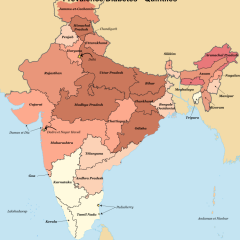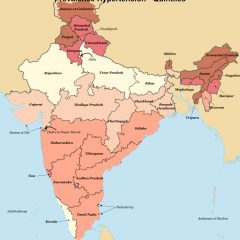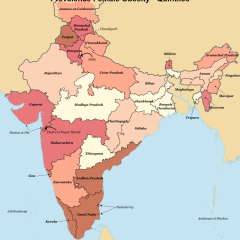Rural Indian Regional Diets
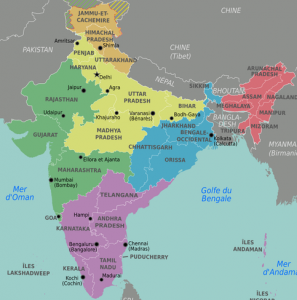 India is divided into 29 states and 9 union territories. In 2014, Telangana was separated from Andhra Pradesh. As a result, the statistics included in this document for Andhra Pradesh also includes Telangana.1
India is divided into 29 states and 9 union territories. In 2014, Telangana was separated from Andhra Pradesh. As a result, the statistics included in this document for Andhra Pradesh also includes Telangana.1
Despite India’s reputation for a healthy, vegetarian cuisine, it is not justified. Only 1.6% of Indians are vegan, 24% are lacto-vegetarian. 3% add eggs to their lacto-vegetarian diet which leaves 72% consuming meat. 2
Religion has a strong influence on diet with Muslims being restricted in eating pork and Hindus from eating beef. Jain and some Hindus have a strong preference for not eating meat.
There is much variation in diets in different regions of India with the uses of dairy, meat, fish, oils, vegetables, the use of spices and cooking methods.
Religion
The highest levels of Buddhist population are found in the northeast with Sikkim (27%), Arunachal Pradesh (12%), Mizoram (9%) and Maharashtra (6%).
Muslims are found more in the north with Lakshadweep (97%) and Jammu & Kashmir (68%) in the far northwest having the highest populations. Assam in the northeast has 34% and West Bengal 27%. Uttar Pradesh, Bihar, Jharkhand and Uttarakhand have a population between 15-20%. In the south, Kerala (27%) is the most significant Islamic area.
Christian households consume much more rice than other religious groups such as Jains, Buddhists and Sikhs who consume a much larger portion of wheat.
The lighter the regions, the higher the incidence of the adherents. Data is from 2011 Indian Census. 3

Indian Regional Diets
From the 1990s, there has been a fall in cereal intake with maize, barley, sorghum and millet being particularly affected. Consumption of vegetables, fruits and milk products has not increased significantly in the diet of rural population.
Regions with higher intake of cereals and milk consume the highest amount of nutrients.
Coarse cereals consist of maize, barley, sorghum, millet and other minor grains.
Pulses, beans and lentils are the central to Indian food. Pulse refers to dried seed. Dhal refers to the split version of pulses such as lentils, peas, chickpeas and kidney beans.
Green gram is the same as mung beans. Black gram is known in India as urad which is similar to the mung bean.
Tomatoes were introduced via Portuguese explorers in the early 16th whilst potatoes were introduced in the early 17th centuries.
The following table shows the percentage difference in food intake when compared to the national average. If the difference is between 90-110%, then it is omitted.
| Food Products | North | Central | West | East | North East | South |
|---|---|---|---|---|---|---|
| Rice & Rice Products | 32% | 72% | 85% | 126% | 190% | 136% |
| Wheat & Wheat Product | 167% | 150% | 78% | 82% | 15% | 18% |
| Coarse Cereals | 147% | 81% | 113% | 48% | 36% | 81% |
| Total Cereal | 112% | |||||
| Pulses | 114% | 114% | 77% | 77% | ||
| Milk (litre) | 203% | 83% | 63% | 51% | 74% | |
| Sugar and Products | 167% | 121% | 54% | 67% | ||
| Edible oil | 67% | 84% | 74% | |||
| Meat Products | 61% | 61% | 67% | 133% | 139% | |
| Vegetables | 86% | 129% | 115% | 80% | ||
| Fruits | 113% | 113% | 81% |
- Wheat consumption is highest in northern, western and central regions. 4
- Rice consumption is highest in northeast, eastern and southern regions. 5
- Western India consume more coarse cereals as well as wheat. Coarse cereals consist of maize, barley, sorghum, many species of millet and other minor grains.
- Meat is highest in southern, north-eastern and north-western regions.
- The major source of fat is edible oils (57%).
- A high level of fish is consumed in the western plains and Ghat, western dry and lower-Gangetic plain regions.
- Vegetable consumption is low throughout the country with a greater prevalence in southern, eastern and northeastern regions.
- Whilst India is known for its lentil dishes, the east and northeastern regions are low in their consumption.
- The northern regions and Gujarat have a particularly high level of dairy products.
There has been a significant decrease in the consumption of maize, barley, sorghum and the many diverse species of millet.
Millets grown in the west and south of India with the states Karnataka, Maharashtra, Tamil Nadu, Madhya Pradesh, Rajasthan and Gujart being the major areas. Although millets have always been secondary to rice, wheat and barley, it has been important in these areas. Millets are able to be grown on land that is not suitable for other cereals.
Millets are good sources of thiamine (B1), riboflavin (B2), pyridoxine (B6) compared to wheat and rice. Millets also have high amounts amounts of folic acid, iron, zinc, calcium, magnesium, sodium, potassium compared to rice and wheat. They are also high in fibre. 6
During the years 1987-1988 and 1999-2000, the consumption of cereals (not including rice or wheat) decreased with millets decreasing significantly. Dairy, added oils, meat and processed food rose with meat, fish, eggs and processed food being particularly significant. These changes were not evenly spread throughout India. Meat, fish and egg consumption rose more than 100% from an already high level in West Bengal. 7
Contribution of millets in total food grain production of India reduced from 22.17% to 6.94% over the last six decades from 1950-51 to 2011-12. 8
The consumption of the cereals barley, maize and millets in rural areas was reduced 50% from 2.59 to 1.30 kg/per capita/30 days during the period from 1987-88 to 1999-2000. In Andhra Pradesh, the consumption was reduced by 75% from 2.3 kg/per capita/30 days. 9
Central Region
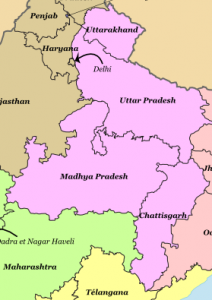 From north to south, the Central Region consists of the states Uttaranchal, Uttar Pradesh, Madhya Pradesh, Chhattisgarh.
From north to south, the Central Region consists of the states Uttaranchal, Uttar Pradesh, Madhya Pradesh, Chhattisgarh.
Uttaranchal is a mountainous region with wheat, buckwheat and millet the predominant grains. Dairy is use is limited.
Uttar Pradesh is the most populous state and home to the Taj Mahal at Agra. Whilst the Himalayas border the state in the north, most of the state are plains. There are wide regional and cultural diversity in food. Wheat consumption is greater than rice.
Madhya Pradesh consumes a greater consumption of dairy and less meat than the other states. Wheat consumption is greater than rice.
Chhattisgarh consumes a greater proportion of meat than the other states. Wheat is the prominent grain along with corn, millet and pulses.
References in the Koran forbidding the use of onion and garlic results in a greater use of asafoetida. It is the dried gum of several species from the Umbelliferae family (parsley, carrots, fennel). It has a pungent, bitter smell that is transformed on cooking into a more subtle garlic or onion flavour.
As well as wheat, maize, millet, wheat, barley, peas, lentils, gram, mustard and potato are grown. The western regions have a high proportion of non-meat eaters with Madhya Pradesh (42%) and Uttar Pradesh (38%).
Fermented foods, including dairy, is important in Uttaranchal and northern Himalayan regions of Uttar Pradesh where food is less spicy and with a greater proportion of chicks, lamb, goat, pork, beef and yak. Some Hindus and Buddhists are strict vegetarians.
Eastern Region
 The eastern region consists of the states Bihar, West Bengal (Bengale Occidental), Jharkhand and Odisha (Orissa). Rice is a more important cereal than wheat in the eastern states than the western states.
The eastern region consists of the states Bihar, West Bengal (Bengale Occidental), Jharkhand and Odisha (Orissa). Rice is a more important cereal than wheat in the eastern states than the western states.
Bihar has the highest rural population (90%) of the Indian states. Chicken and mutton are the most common meat consumed. Fish is prevalent in the northern region which is a flat region with numerous rivers. Dairy products are common: butter; ghee; yogurt; matha (a sweet, spiced buttermilk); and lassi (a drink made from yogurt, spices, water and fruit). Bihar has the highest non-meat consumers (18%) in the region.
West Bengal (Bengale Occidental) contains Kolkata and the Ganges delta. Darjeeling is in the far north of the state which is in the foothills of the Himalayas with an altitude of up to 2000m.
Jharkhand staple foods are rice, pules, vegetable and tubers. As well as potatoes, there are a number of foods that are gathered from the forest. The food of Jharkhand and Odisha is less spicy than other regions.
Odisha is located on the eastern coast. The eastern region consists of a narrow coastal plain with mountainous regions to the west. Major rivers intersect the state. The prohibition of garlic and onions is lifted. Rice replaces wheat as the major cereal. Vegetable and fruit consumption is high as is meat consumption. Dairy consumption is low. Garlic, turmeric, chili and ginger are common spices.
Northeastern Region
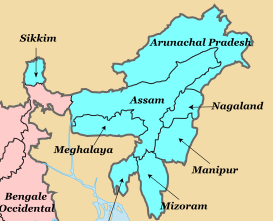 The northeastern region comprises of 7 contiguous states of Arunachal Pradesh, Assam, Manipur, Meghalaya, Mizoram, Nagaland, Tripura with Sikkam being a separate state in the NW of the region. The climate is mostly subtropical with a very high rainfall.
The northeastern region comprises of 7 contiguous states of Arunachal Pradesh, Assam, Manipur, Meghalaya, Mizoram, Nagaland, Tripura with Sikkam being a separate state in the NW of the region. The climate is mostly subtropical with a very high rainfall.
The northern states of Arunachal Pradesh and Sikkim are mountainous regions with cold winters and mild summers. The other states are are mostly subtropical with a very high rainfall.
Rice is the important grain. Tea is grown extensively.
Arunachal Pradesh is the northern most state of the region. Pork, poultry and mithun (bovine species that is native to the northeastern region as well as Bangladesh, Myanmar, Yunnan, province in China.)
Assam is another state that has a high meat diet with duck, goose as well as other poultry and fish prevalent. Food is preserved by drying and fermentation. Mustard oil is used extensively. Leafy greens are gathered from the wild.
Manipur has a greater variety of food than the other northeastern states. The food is spicier with more vegetables. It shares with its neighbours an extensive use of mustard oil.
Meghalaya is a mountainous region – the wettest place on earth. Pork, chicken and fish are common with a limited use of spices. Local gathered foods such as mushrooms are utilised.
Mizoram consume pork, chicken and mithun which are dried and smoked for preservation. Plants and mushrooms are gathered from the wild as well as produced that is provided by small home gardens. Garlic, chili, onions, ginger and mustard oil are utilised extensively. Orchards provide a plentiful supply of fruit.
Nagaland has many different tribal groups with their own style of cooking. Poultry, pork, beef and fish are eaten. Food is preserved by salting, smoking and fermenting. A very spicy chili is frequently used.
Tripura is a hilly area with a subtropical climate in the south of the region. Pork, bison and fish are common meats. Fermented fish products are common. Mustard oil, with its pungent taste, is used liberally.
Sikkam has the highest proportion of Buddhists (27%) than any other Indian state and as a result has a greater proportion of vegetarian dishes than the other states of the NE. Fermented food is an important part of the diet.
Northern Region
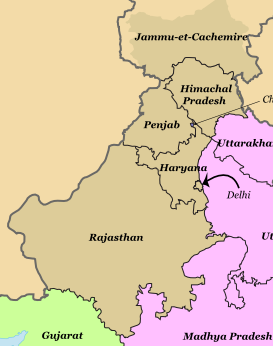
Indian northern region comprises of the states Jammu and Kashmir, Himachal Pradesh, Punjab, Haryana, Rajasthan as well as the cities and union territories of Delhi and Chandigarh.
Delhi contains New Delhi, the capital of India. Chandigarh is the capital of the neighbouring states of Punjab and Haryana.
Wheat is the main grain in the north with wheat being produced and consumed in much greater quantities than rice. There are many wheat flat breads such as roti and naan.
Muslims are happy to use onions and garlic, whereas the Hindus prefer to use asafoetida. It is the dried gum of several species from the ubiquitous Umbelliferae family (parsley, carrots, fennel). It has a pungent, bitter smell that is transformed on cooking into a garlic or onion flavour. Wheat is the main grain. The use of millets and barley are declining due to commercial growing of wheat although concerted efforts are being made to reintroduce these important foods.
Dairy in the form of milk, cream, panner (a fresh soft cheese made by curdling milk with fruit-derived acid) cottage cheese, ghee (clarified butter) and yogurt are utilised.
Mustard oil is an important part of diet.
Jammu and Kashmir is a former state that was reorganised into three union territories in 2019: Jammu and Kashmir in the west and Ladakh in the east. This is the only region in India with a Muslim majority population. The main meats consumed are lamb, chicken and beef.
Himachal Pradesh is a mountainous region in the western Himalayas. 45% of the population are non-meat eaters. Fish is consumed less frequently. In common with the 4 southern states, there is a higher consumption of dairy and lower consumption of meat than other areas of India. Bread, lentils, yogurt, pickles and chutney as well as rice are common fare.
Punjab has a high consumption of dairy with 50% of the population being non-meat eaters. Significant use of ghee, panner and fermented milks and mustard oil. Poultry, lamb and goat are the main meats consumed.
Haryana has a high consumption of dairy with 70% of the population being non-meat eaters – the highest in India. It mostly consists of plain region with foothills of the Himalayas in the north east and a desert region in the south west.
Potatoes, onions, tomatoes, brassicas, green leafy vegetables, legumes and fruit (citrus, guava and mango) are important components of diet. Spices include garlic, fenugreek and ginger.
Murrah, a breed of water buffalo, is utilised for milk production. Similarly with other northern states, dairy is consumed in high quantities.
Rajasthan is a largely desert state. A range of mountains run for most of the state from the south west to north east. The capital is Jaipur. Rajasthan has a very high consumption of dairy, with only Haryana being higher, with 60% of the population being non-meat eaters. Consumption of meat is very low, being the lowest in India.
It is similar to other northern states with less vegetables because of shortage of water. The food is spicy.
Southern Region
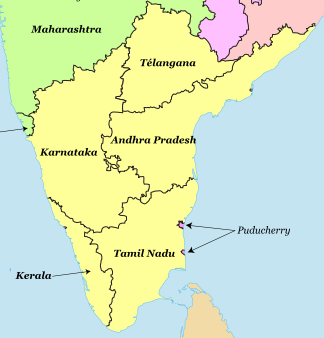
The coastal Western and Eastern Ghats border the southern part of India with the southern plateau and hills in the central region. In 2014, Telangana was separated from Andhra Pradesh. Both states share the capital Hyderabad.
The region consists of the states Telangana, Andhra Pradesh, Karnataka, Tamil Nadu and Kerala. Paducherry is a union territory consisting of two separate districts within the state of Tamil Nadu.
Telangana is an inland state in the north of the region. Rice is consumed much more than wheat. Millets are being reintroduced after several decades of neglect. Food is very spicy with hot varieties of pickles prevalent.
Andhra Pradesh has a long coast line. As a result, fish and coconut oil are important foods. Rice is the main grain along with lentils which are used in sambars (lentil-based vegetable stew with tamarind) and dhals.
Tamarind with its tangy sour taste is often tempered with sugar. Tamarind rice with green chilies, chutneys and pickles make this food the hottest and spiciest in India.
Karnataka comprises of a coastal region, the western hills and the plateau region. There are distinct dietary areas with coconut and fish more prevalent on the coast. Wheat is utilised more in the north. Mutton and pork with curries that are milder than other southern regions.
Tamil Nadu is another relatively high meat consuming region. It shares with Andhra Pradesh the liberal use of tamarind. Curries are sweeter and not as spicy as Andhra Pradesh.
Kerala has the highest life expectancy of the Indian states (this does not include Goa which is not included in the statistics). In contrast with other Indian states, the difference between rural and urban life expectancy is less than one year. Kerala has a tropical, monsoonal climate.
The Portuguese were the first Europeans to arrive in Kerala when Vasco da Gama arrived in 1498. As well as taking political control of the region, they introduced foods such as potatoes, tomatoes, cashews, mangoes, pineapples, chillies and vinegar which had a significant impact on the diets of the region.
The food is similar to that of Goa in the north but the food tends to be spicier than that of Goa.
Western Region
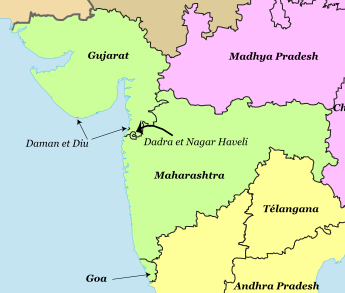
The western region consists of the states Gujarat, Maharashtra and Goa.
Gujarat has the longest coastline of the Indian states. Gujarat has a low consumption of meat with only Rajasthan and Punjab being lower.
The northern peninsular of Gujarat is a sparsely populated dry area consisting of sand and mud flats. To the west, are low lying marsh lands with saline soils. These soils are much less fertile than other regions of Gujarat which consist of productive, fertile loams. Due to the poorer soils of northern Gujurat, the population consumes significantly less calories, vitamin C, protein and minerals in general. 10
The state consumes more rice than wheat. Millets were an important component of the diet which are making a resurgence. Gujarat food is high in dairy, sugar and fat. Fat consumption is the highest in India.
Cereals, roasted cereals, potatoes, sweet potatoes, legumes, tomatoes, yogurt, sweeten milk, ghee and butter-milk. Spices sweet, salty, and spicy with fenugreek, green and red chili, thyme, garlic and mustard. Chutney and pickles are utilised. Chicken, goat, mutton and seafood in coastal areas are the main meats.
Maharashtra state consists of a narrow coastal plan, the western ghats (a narrow rugged hill region that rises to 1,000m) with the majority of the state consisting of the Deccan Plateau.
Once again, there are regional and religious differences. The food is high in dairy, sugar and fat. Cow and water buffalo milk, yogurt, spiced buttermilk, butter and ghee are consumed.
In the northern coastal regions, rice is more predominant. Coconut and coconut milk along with fish and very hot spicy food are consumed. In other regions, wheat is much more predominant with wheat and millet flat breads.
Peas, potatoes and gram dhal, tomatoes, bananas and jackfruit are also used utilised. Spices include asafoetida, turmeric, mustard seeds, coriander, cumin, dried bay leaves and chili. Herbs used include tamarind, coriander, garlic, onion, ginger and read and green chilli. Chicken, goat and mutton are the main meats.
Goa was under control of Portuguese colonial rule from 1510 until 1961. Two centuries prior, there was a strong Muslim influence. It has the highest GDP per capita of the Indian states. Life expectancy figures are not available for Goa.
It has a tropical, monsoonal climate.
As as result of Portuguese influence, consumption of beef and pork is higher than other states. Whilst fish consumption is high, the consumption of other meats are low.
Hindu cuisine is lacto-vegetarian or lacto-vegetarian with fish (pesco-vegetarian). The Hindu cuisine is tends to be mild, using spices asafoetida, fenugreek, curry leaves, mustard, garlic, onion and tamarind.
Rice is the main food crop. Maize, barley, sorghum (jowar), pearl millet (bajra), finger millet (ragi) and small millets (foxtail, barnyard, little, common millet – also known as white or proso millet) were grown much more frequently in the past.
Coconut is widely used in food and as an oil for cooking.
Indian Agroclimatic Regions
India is divided into 15 agroclimatic regions. The Indian Ocean island region of Andaman-Nicobar and Lakshadweep is not considered in the discussion below.
Indian Diet and Health
The Indian population has the highest prevalence of diabetes worldwide and exhibits high-risk metabolic profiles at younger ages and lower body mass index than their Western counterparts. There are significant regional variations in diet and health. According to the authors’ of a 2011 paper, the “dietary patterns characterized by animal products, fried snacks, or sweets appeared to be positively associated with abdominal adiposity. Conversely, more traditional diets in the Southern regions were inversely related to diabetes and hypertension.” 11
The following table shows the 15 most populous states and food expenditure in Rural India (which the authors relate to consumption) in 9 food groups as a percentage of total food expenditure. All foods belong to one food group. 12
| State | 1 Cereal | 2 Roots | 3 Sugar | 4 Pulses & Nuts | 5 Veg & Fruit | 6 Meat | 7 Dairy | 8 Oils | 9 Misc |
|---|---|---|---|---|---|---|---|---|---|
| ALL | 68 | 3 | 5 | 5 | 2 | 1 | 6 | 7 | 3 |
| Andhra Pradesh | 69 | 1 | 3 | 5 | 2 | 1 | 5 | 8 | 4 |
| Assam | 73 | 3 | 3 | 4 | 3 | 2 | 3 | 7 | 4 |
| Bihar | 74 | 4 | 3 | 4 | 2 | 0 | 5 | 6 | 2 |
| Chhatisgarh | 78 | 2 | 4 | 5 | 2 | 0 | 1 | 6 | 2 |
| Gujrat | 58 | 2 | 7 | 5 | 3 | 0 | 9 | 13 | 3 |
| Haryana | 54 | 2 | 9 | 3 | 2 | 0 | 20 | 6 | 3 |
| Jharkhand | 75 | 5 | 3 | 3 | 2 | 1 | 3 | 6 | 3 |
| Karnataka | 66 | 1 | 6 | 7 | 2 | 1 | 6 | 7 | 4 |
| Kerala | 54 | 4 | 6 | 9 | 3 | 4 | 5 | 6 | 7 |
| Madhya Pradesh | 69 | 2 | 5 | 5 | 2 | 0 | 6 | 8 | 2 |
| Maharashtra | 62 | 2 | 7 | 8 | 2 | 1 | 5 | 10 | 4 |
| Orissa | 79 | 4 | 2 | 3 | 2 | 1 | 1 | 4 | 3 |
| Punjab | 50 | 3 | 11 | 5 | 2 | 0 | 17 | 9 | 3 |
| Rajasthan | 65 | 1 | 6 | 3 | 2 | 0 | 15 | 7 | 2 |
| Tamil Nadu | 68 | 1 | 3 | 7 | 2 | 1 | 5 | 7 | 6 |
| Uttar Pradesh | 67 | 4 | 5 | 6 | 2 | 0 | 7 | 7 | 2 |
| West Bengal | 73 | 5 | 3 | 2 | 2 | 2 | 2 | 7 | 3 |
| Min: 50 Max: 78 | Min: 1 Max: 5 | Min: 2 Max: 11 | Min: 2 Max: 9 | Min: 2 Max: 3 | Min: 0 Max: 4 | Min: 1 Max: 20 | Min: 4 Max: 13 | Min: 2 Max: 7 |
I-Cereal, II-Roots & fibre, III-Sugar & honey, IV-Pulses, nuts & oilseed, V-Veg & fruits, VI-Meat, egg & fish, VII-Milk and milk product, VIII-Oils & fats, IX-Misc. food & prod
The reasons why Asian populations exhibit diabetes at a lower threshold than western populations are not known.
According to WHO figures mortality statistics, out of 183 countries, India is ranked: 13
- 17 for Low Birth Rate
- 37 for Diarrhoeal Diseases
- 40 for Tuberculosis
- 60 for Malnutrition
- 62 for Influenza & Pneumonia
There is a large variation between states in risk factors associated with health between the states. 14
In the data below, diabetes was defined as a fasting plasma glucose level >= 7.0 mmol/L or >= 11.1 mmol/L for non-fasting. Hypertension as systolic blood pressure of at least 140 mmHg or diastolic blood pressure of at least 90 mmHg. The threshold for these definitions are high with optimal fasting glucose being 5.5-6.0 mmol/L and systolic blood pressure being less than 120 mmHg.
Age-standardized diabetes prevalence for men rose from 3.7% to 9.1% for women from 4.6% to 8.3% between the years 1980 to 2014. 15
- Smoking – Women: Tamil Nadu (0.0%) to Mizoram (18%)
- Smoking – Men: Maharashtra (16%) to Mizoram (67%)
- Obesity (BMI >= 25): Madhya Pradesh (8%) to Kerala (27%)
- Hypertension: Andhra Pradesh (17%) to Madhya Pradesh (21%)
- Diabetes – Women: Mizoram (0.5%) to Kerala (5.3%)
- Diabetes – Men: Madhya Pradesh (0.6%) to Kerala (6.5%)

There is a large variation in life expectancy between rural and urban populations and state populations. (Data from 1998-2002) The lowest life expectancy in rural India is Madhya Pradesh at 55.6 years with Kerala having the highest at 73.4. The difference between rural and urban populations is greatest in Assam at 9.5 years. 16
Yellow shows the lowest third, blue the middle third and green the highest third.
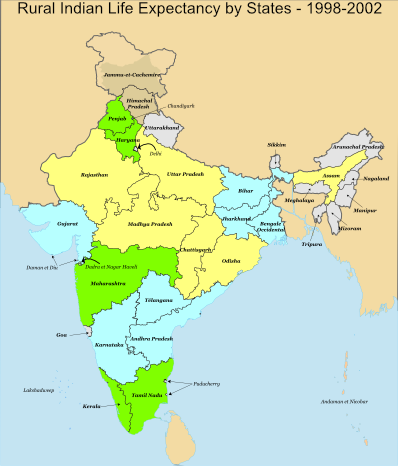
Last updated on Tuesday 2 April 2024 at 20:06 by administrators
Footnotes
- Rao, Ravikiran, Cacahuate, and Nichalp. 2009. “Map of India (Regions).” https://commons.wikimedia.org/wiki/File:Map_of_India.png. Rights: Creative Commons Attribution 4.0
- Agrawal, S. et al. (2014) Type of vegetarian diet, obesity and diabetes in adult Indian population. Nutrition Journal. 13 (1), 1.
- Census Organization of India (2011) Religion Data – Population of Hindu / Muslim / Sikh / Christian – Census 2011 India [online]. Available from: https://www.census2011.co.in/religion.php (Accessed 30 March 2020).
- Vij, S. (2014) Rice and wheat maps of India: Rajasthan doesn’t eat rice, rotis a rarity in Manipur.
- Vij, S. (2014) Rice and wheat maps of India: Rajasthan doesn’t eat rice, rotis a rarity in Manipur.
- Konapur, A. et al. (n.d.) Millets in Meeting Nutrition Security: Issues and Way Forward for India.
- Konapur, A. et al. (n.d.) Millets in Meeting Nutrition Security: Issues and Way Forward for India.
- Malathi, B. et al. (2016) Growth pattern of millets in India. Indian Journal Of Agricultural Research. 50 (4)
- Chatterjee, S. et al. (2007) Food consumption and calorie intake in contemporary India.
- Ghosh, S. & Kumar, M. (2019) Prevalence and associated risk factors of hypertension among persons aged 15–49 in India: a cross-sectional study. BMJ Open. 9 (12), e029714.
- Daniel, C. R. et al. (2011) A cross-sectional investigation of regional patterns of diet and cardio-metabolic risk in India. Nutrition Journal. 10 (12).
- Indian National Sample Survey Organisation (2007) Nutritional Intake in India 2004-2005: NSS 61st Round. page 58 Statement 5A
- World Life Expectancy (n.d.) World Life Expectancy – Statistics [online]. Available from: http://www.worldlifeexpectancy.com/.
- Gupta, R. et al. (2012) Regional variations in cardiovascular risk factors in India: India heart watch. World Journal of Cardiology. 4 (4), 112.
- Tandon, N. et al. (2018) The increasing burden of diabetes and variations among the states of India: the Global Burden of Disease Study 1990–2016. The Lancet Global Health. 6 (12), e1352–e1362.
- Ghosh, M. (2011) Regional Disparities in Education, Health and Human Development in India. Indian Journal of Human Development. 5 (1), 5–28.
